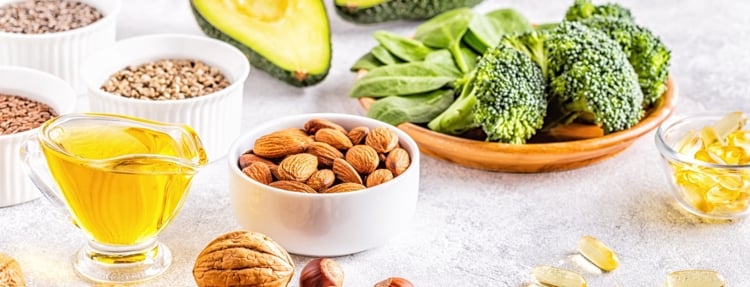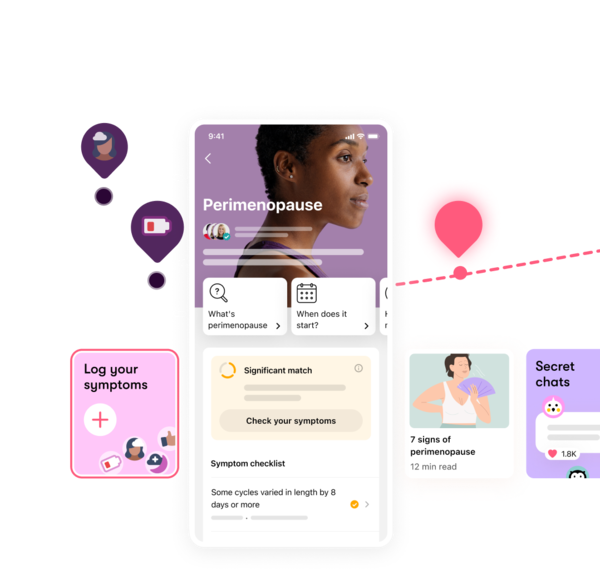Phytoestrogens are naturally occurring nutrients derived from plants, and although they’re not generated in the body, they are similar to estrogen in some ways. This article will give you information about five different foods high in phytoestrogen and how they can influence menopause symptoms.
-
Tracking cycle
-
Getting pregnant
-
Pregnancy
-
Help Center
-
Flo for Partners
-
Anonymous Mode
-
Flo app reviews
-
Flo Premium New
-
Secret Chats New
-
Symptom Checker New
-
Your cycle
-
Health 360°
-
Getting pregnant
-
Pregnancy
-
Being a mom
-
LGBTQ+
-
Quizzes
-
Ovulation calculator
-
hCG calculator
-
Pregnancy test calculator
-
Menstrual cycle calculator
-
Period calculator
-
Implantation calculator
-
Pregnancy weeks to months calculator
-
Pregnancy due date calculator
-
IVF and FET due date calculator
-
Due date calculator by ultrasound
-
Medical Affairs
-
Science & Research
-
Pass It On Project New
-
Privacy Portal
-
Press Center
-
Flo Accuracy
-
Careers
-
Contact Us
Estrogen-Rich Foods: Five Foods High in Estrogen


Every piece of content at Flo Health adheres to the highest editorial standards for language, style, and medical accuracy. To learn what we do to deliver the best health and lifestyle insights to you, check out our content review principles.
Research hasn’t yet determined if phytoestrogens can really help with symptoms associated with menopause. Like any other supplement, phytoestrogens can have side effects and risks, so it’s important to consult a health care provider before taking any medications or supplements.
How do foods that boost estrogen work?
Hormonal balance is important for health. Estrogen is the primary female hormone produced in the body, and it’s responsible for many different functions.
Here are just a few things that estrogen does in the body:
- Regulates nervous system functions, maintains body temperature, and enhances the effects of endorphins (feel-good chemicals)
- Improves skin quality and prevents aging (collagen levels)
- Preserves the strength of bones and prevents bone loss
- Regulates the production of cholesterol in the liver
- Increases vaginal acidity and reduces the risk of bacterial infections
- Controls hair growth and prevents hair loss/thinning
If someone’s hormones are out of balance, it can affect their mood, sleep, and ability to conceive, and also make them more susceptible to hormone-related medical conditions. Some of these conditions include polycystic ovary syndrome, early-onset menopause, infertility, hirsutism (male-pattern hair growth), and cancer in some rare cases.
There are foods that are rich in phytoestrogen, which is similar to the estrogen produced in the body. They might help in cases of a lack of estrogen as they have somewhat similar functions, although they might also interfere with estrogen functioning itself. There is still not enough data on whether some foods can boost estrogen and what side effects phytoestrogen can cause.
Low-estrogen symptoms and complications
Estrogen is closely linked to how a person feels, their mood, and general well-being. If estrogen levels are low, it can cause some noticeable symptoms, including:
- Mood swings
- Depression
- Anxiety
- Emotional outbursts
- Anger
- Aggression
- Irritability
- Social withdrawal
These symptoms can also include things that are sometimes part of a normal menstrual cycle, such as bloating, breast tenderness, weight gain, and acne. Others consider symptoms such as hair loss, insomnia, painful sex, decreased libido, and amenorrhea (absence of periods) part of the normal aging process.
If you suddenly experience these symptoms and aren’t pregnant or approaching menopause, make sure to see a health care provider. They will be able to assess your symptoms and check your hormone levels to rule out any other medical conditions that may cause similar effects.
If the cause is a lack of estrogen, some treatments can be suggested, including hormone replacement therapy. Phytoestrogen treatment as an alternative in cases of estrogen deficiency is currently being studied, and its efficiency and possible side effects are not fully known yet.
Take a quiz

Track symptoms and patterns
Learn to spot patterns in your cycle as they can provide insight into underlying medical conditions
Low estrogen during menopause: Symptoms
The best way to confirm if symptoms are due to low estrogen levels caused by menopause is to see a health care provider. They will evaluate any symptoms and measure current hormone levels.
People in their late 40s or early 50s who are experiencing any or all of the symptoms listed below could be beginning the menopausal transition. These symptoms can include the following:
- Changes in skin texture
- Hair loss/thinning
- Amenorrhea (absence of periods)
- Decreased libido
- Vaginal dryness
- Hot flashes and night sweats
- Depression
- Insomnia
- Painful sex
- Forgetfulness
- Difficulty concentrating
- Frequent headaches
- Dry eyes
- Frequent urinary tract infections
These symptoms associated with perimenopause and menopause can be inconvenient at times, but there are solutions. Currently, researchers are studying natural ways to control these symptoms with phytoestrogen-rich foods in cases where hormone replacement therapy isn’t possible.
For now, there is not enough data on the effects of phytoestrogens. The claims about the potentially beneficial effects of phytoestrogens for menopausal symptoms might be overstated. Some clinical trials have found that the positive effects phytoestrogens can have on menopausal symptoms are about as good as those from a placebo. In addition, researchers may ignore the potential adverse effects in the hopes of finding a treatment that works. Before making changes in your diet, consult a health care provider and discuss possible outcomes for your health.
5 foods high in estrogen
Lots of people want to know which foods are rich in phytoestrogen. Here are five different options for foods high in phytoestrogen, which some people claim might reduce typical symptoms associated with menopause.
1. Red wine
Take a quiz
Find out what you can do with our Health Assistant

Consuming phytoestrogen-rich foods and drinks like red wine in moderation (up to 5 ounces/148 milliliters a day for women of all ages) has been shown to reduce the risk of cardiovascular disease and breast cancer. Research has now revealed that it may be due to phytochemicals in the skins of the grapes used to make red wine.
This phytochemical is known as resveratrol, which has been shown to provide the benefits of natural estrogen.
The American Heart Association and National Heart, Lung, and Blood Institute don’t recommend starting to drink alcohol just to prevent diseases.
If you are not a fan of red wine, this same phytochemical can be found in other phytoestrogen-rich foods such as red grapes, cranberries, blueberries, and peanuts.
2. Fruits (fresh and dry)
Dry fruits such as apricots are a good source of fiber, antioxidants, and vitamins (including vitamin C). They are also an estrogenic food. These foods contain a type of antioxidant that has been shown to improve blood circulation and protect against a host of diseases. They can be eaten alone or in cereal, yogurt, or salads.
Fresh apricots, peaches, red grapes, oranges, blueberries, and strawberries are also all great sources of phytoestrogen, vitamins, antioxidants, and fiber. Fresh fruit can be added to any meal or make great desserts.
3. Nuts
Nuts are not only an easy snack full of protein, but also a food high in phytoestrogen. They can be eaten raw or roasted. Nuts like pistachios, peanuts, and walnuts are also sources of phytoestrogen. Try adding them to a snack mix or on top of a salad for extra crunch.
4. Flax seeds
When it comes to estrogenic foods, flax seeds rank near the top. They have the highest amount of phytoestrogen content out of all the phytoestrogen-rich foods. Flax seeds are also a great source of dietary fiber, which helps to lower cholesterol and regulate the digestive tract. This is because of their high concentration of omega-3 fatty acids. They can easily be incorporated into other foods that you may already eat. You can add the seeds to cereal, use them as a salad topping, or add them to yogurt or smoothies.
5. Soy
Some people find it beneficial to include soy products in their diet. Soy is probably the most studied phytoestrogen-rich food for menopause. Many of these studies were done as a result of the low percentages of heart disease and menopausal symptoms observed among Asian women. The theory is that soy is eaten on a regular basis in Asian cultures, low heart disease and menopausal symptoms might be linked to soy being rich in phytoestrogen. Nevertheless, more research is needed to prove this definitively. Still, nearly every study researching foods high in estrogen has included a finding associated with soy and soy products.
Soy is an excellent source of protein and healthy oils. But it is the isoflavone content that makes it stand out nutritionally. Research shows that isoflavones might be able to counteract decreasing estrogen levels during menopause and reduce hot flashes, night sweats, vaginal dryness, and other symptoms.
These phytoestrogen-rich foods may have some health benefits, although there is a lack of scientific evidence on their effectiveness and possible risks. Make sure to consult a health care provider before significantly changing your diet or taking any supplements.


Hey, I'm Anique
I started using Flo app to track my period and ovulation because we wanted to have a baby.


The Flo app helped me learn about my body and spot ovulation signs during our conception journey.


I vividly
remember the day
that we switched
Flo into
Pregnancy Mode — it was
such a special
moment.
Real stories, real results
Learn how the Flo app became an amazing cheerleader for us on our conception journey.
References
History of updates
Current version (13 November 2020)
Published (02 May 2019)
In this article

Track your perimenopause journey in the Flo app
-
Log symptoms and get tips to manage them
-
Learn what to expect with expert-led articles and videos
-
Connect with others who can relate to how you're feeling




